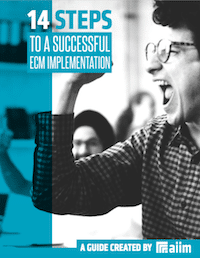The AIIM Blog
Keep your finger on the pulse of Intelligent Information Management with industry news, trends, and best practices.
The fourth in my series of six issues relative to getting rid of paper focuses on what I call Cloud Craziness. See also… Paperless Dilemma No. 1 – Paper Persistence Paperless Dilemma No. 2 – Legal Limbo Paperless Dilemma No. 3 – Input Irregularity As many readers know, I usually view cloud and mobile as the twin steroids of business disruption, so let me start with mobile and then shift to the cloud.
Share
Cloud | Compliance | Privacy
Data Protection laws and regulations across the EU govern the storage and processing of data that would allow an individual to be recognized. They are intended to address the risks around privacy and data loss and to provide a framework for good information governance. The development of public, private, government, and hybrid cloud computing services has created a challenge to on-premise data storage and processing, and thus created uncertainty regarding responsibilities of the respective organizations regarding data protection and data privacy. The European Union is soon to implement the General Data Protection Regulation (GDPR), which will bring all 27 countries under a single regime of rules, and penalties for breach. AIIM regards this as an opportunity for cloud providers to deliver EU-wide services under a single operations model. However, providers and users need to be aware of the current legislative challenges. The purpose of a new AIIM white paper -- Making sense of European Data Protection Regulations as they relate to the storage and management of content in the Cloud – is to inform end-users of the current and potential future legislative landscape in Europe regarding data protection and data privacy. This will enable end-user organizations to make risk-based decisions about cloud versus on-premise content storage. This will also allow them to evaluate providers of cloud services to ensure that they will stay compliant with applicable law.
Share

Making an ECM implementation successful requires planning and attention to detail. The best way to create the right solution is to identify organizational goals and priorities. Learn how to manage a successful implementation in our free guide.
Technology changes what is possible. Every “age” has a feel, a zeitgeist. That zeitgeist is very much a function of the fact that every age has a defining technology. The age we are just now entering has four defining technologies – Social, Mobile, Analytics, & Cloud – the SMAC stack. The economics and ergonomics of experimentation have changed. It has never been easier – or more profitable – to do new things. To do new things require new modes of thought. That is why I advocate a “cognitive reboot.”
Share
We've all just about had it with monolithic proprietary systems that cost lots of money in purchase costs and annual service, require expensive customizations in order to get anything actually done, with frequent upgrades requiring additional consulting services just to do the upgrade, followed by yet more consulting services to port the previous customizations to the upgrade, and on and on and on.
Share
Certified Information Professional (CIP) | Cloud | Enterprise Content Management (ECM) | Mobile | Social Media
I’ve been thinking about this on and off for a while, and as a result, the post is a bit longer than normal. I would welcome your thoughts in the comments section. What do you think? What rings true? Where do you think I’m nuts?
Share
1. It’s safer than you think. When transferring massive amounts of important documents onto virtual servers, security is a common concern. A ‘cloud’ doesn’t sound safe—it sounds like anyone can reach inside and take what they want. People think that since something so intangible can’t be impenetrable, on-site servers are a smaller risk. You can see them, touch them, and put padlocks on them. What could be more secure? Cloud networks, for one. The fact is that their security measures frequently surpass those of traditional corporate infrastructure. Just because you don’t see where your information’s going doesn’t make life in the clouds any more dangerous: virtual servers can be just as safe as physical ones—and often safer.
Share